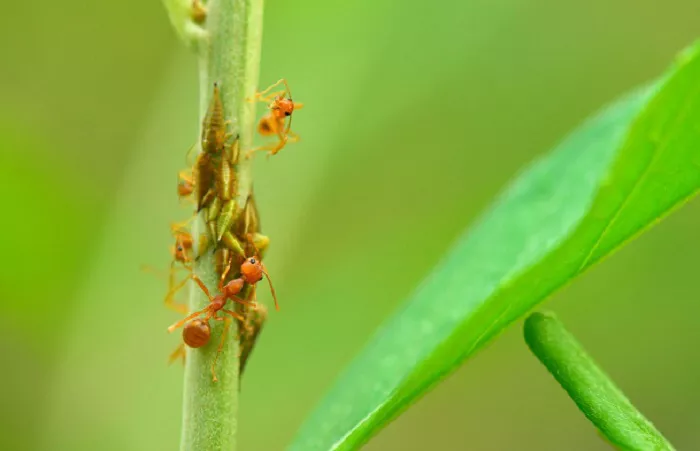Fire ants can be a persistent and unwelcome presence in our gardens, especially when they invade our beloved flower pots. These tiny but formidable insects can damage plants, disrupt the soil ecosystem, and even pose a threat to gardeners with their painful bites. However, with the right strategies and a bit of effort, you can keep your flower pots free from fire ants and ensure a thriving, healthy garden.
Understanding Fire Ants
The Nature of Fire Ants
Fire ants are highly adaptable and thrive in a variety of environments. They are attracted to moist soil and organic matter, making flower pots an ideal habitat. These ants are known for their aggressive behavior and ability to build complex nests. Understanding their habits is the first step in preventing them from taking over your flower pots.
Signs of Fire Ant Infestation
Before taking action, it’s important to identify if you have a fire ant problem. Look for small mounds of soil around the base of your flower pots or on the surface of the soil. Fire ants may also be seen crawling on the plants or the pot itself. Additionally, if you notice your plants wilting or showing signs of stress, fire ants could be the culprits, as they can damage roots and disrupt the soil structure.
Preventive Measures
Choosing the Right Potting Mix
The type of potting mix you use can play a crucial role in deterring fire ants. Opt for a well-draining mix that is less likely to retain excess moisture. Fire ants prefer damp environments, so keeping the soil slightly drier can make your flower pots less appealing to them. Additionally, avoid using organic materials that may attract ants, such as kitchen scraps or heavily composted soil.
Physical Barriers
Creating physical barriers is an effective way to keep fire ants out of your flower pots. One simple method is to place a layer of coarse sand or gravel at the bottom of the pot before adding soil. This can deter ants from entering the pot through drainage holes. Another option is to use copper tape around the rim of the pot. Copper is known to repel ants, as it creates a mild electric shock when they come into contact with it.
Natural Deterrents
Nature provides several solutions to keep fire ants at bay. Diatomaceous earth, a natural powder made from fossilized diatoms, can be sprinkled around the base of the flower pot. It works by damaging the exoskeleton of the ants, causing them to dehydrate and die. Additionally, certain plants, such as mint, lavender, and rosemary, are known to repel ants. Planting these herbs around your flower pots can create a natural barrier.
Maintaining Cleanliness
A clean garden environment is essential for preventing fire ant infestations. Regularly remove any fallen leaves, dead plant material, or debris from around your flower pots. These items can provide a food source and shelter for ants. Also, avoid leaving standing water in saucers or trays, as it can attract fire ants and other pests.
Dealing with Existing Infestations
Safe and Effective Treatments
If you already have fire ants in your flower pots, there are several safe and effective treatments you can use. One option is to use ant baits specifically designed for fire ants. These baits contain a slow-acting poison that the ants carry back to their colony, effectively eliminating it from the inside. Place the bait near the infested pot, but be sure to keep it out of reach of children and pets.
Hot Water Treatment
For a more immediate solution, you can try the hot water treatment. Boil a pot of water and carefully pour it into the flower pot, ensuring that it reaches the base. This method can kill the ants and their larvae, but be cautious not to damage the plant roots. It’s best to do this in the morning when the ants are more active and closer to the surface.
Repotting Affected Plants
In severe cases, repotting the affected plant may be necessary. Carefully remove the plant from the pot, shaking off as much soil as possible to dislodge the ants. Inspect the roots for any signs of damage and trim any affected areas. Then, repot the plant in fresh, ant-free soil. Be sure to clean the pot thoroughly before reusing it.
Ongoing Maintenance
Regular Inspections
To keep fire ants out of your flower pots, regular inspections are key. Check your pots weekly for any signs of ant activity. Look for mounds, crawling ants, or distressed plants. Early detection can help you address any issues before they become major problems.
Encouraging Natural Predators
Introducing natural predators into your garden can help keep fire ant populations in check. Certain insects, such as predatory beetles and parasitic flies, feed on fire ants. Encouraging these beneficial insects by providing a diverse and healthy garden environment can be an effective long-term solution.
Adjusting Watering Practices
Adjusting your watering practices can also help deter fire ants. Instead of watering your plants from above, consider using a drip irrigation system or watering from the bottom. This method keeps the soil surface drier, making it less attractive to fire ants.
Conclusion
Fire ants can be a nuisance in the garden, but with the right strategies, you can keep them out of your flower pots and protect your plants. By understanding their habits, implementing preventive measures, and addressing any infestations promptly, you can enjoy a thriving and ant-free garden. With a little effort and attention, your flower pots will remain a safe haven for your beloved plants.


